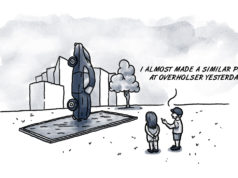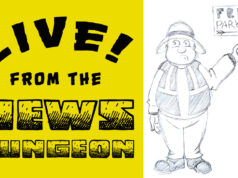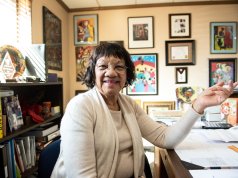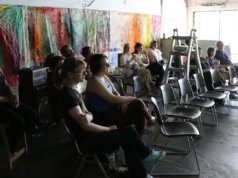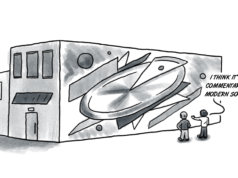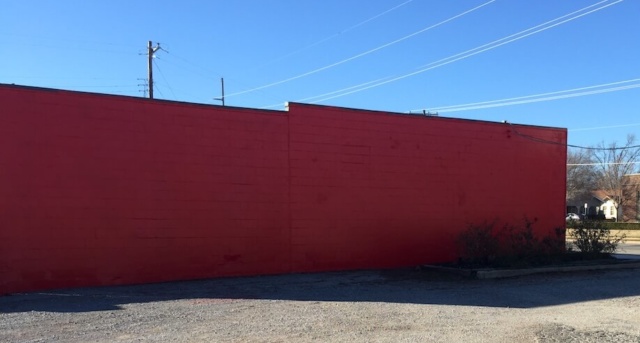
A local advertising and printing company’s decision to paint over a mural on Western Avenue has caught district leaders by surprise and has spurred a conversation about public art.
The mural, painted by prolific artist Bob Palmer, was part of an ongoing installation by the Western Avenue District Association, according to Jerrod Smith, chairman of the association’s mural project.
“It sounds like [the business moving in] is just going to say, ‘Well, we wanted to paint over it so we did,’” Smith said Monday before speaking with the business owner. “But it’s a problem because the guy who painted it — whether you like the mural or not — made history in Oklahoma City for public art. He’s painted all over the world.”
Smith was referring to 66-year-old Palmer who has been painting murals for about 25 years. Among hundreds of other projects, Palmer contributed heavily to Oklahoma’s Centennial celebration in 2007, and his website features murals in Canada and Macedonia.
“He’s a talented dude, and he deserves people’s respect because of the tenure,” Smith said. “The way public art exists right now in Oklahoma City wouldn’t exist without Bob Palmer.”
Jen Hutchings, owner of Alotta Action Advertising, offered a frank and alternate view of Palmer’s mural that is now covered by red paint on the southeast corner of Northwest 46th Street and Western Avenue.
“That mural was ugly, and we are going to put a new mural on it,” Hutchings said by phone Monday. “If you have any issues with it, you can contact my landlord, Rex Baker. Otherwise I don’t need to be bothered with this.”
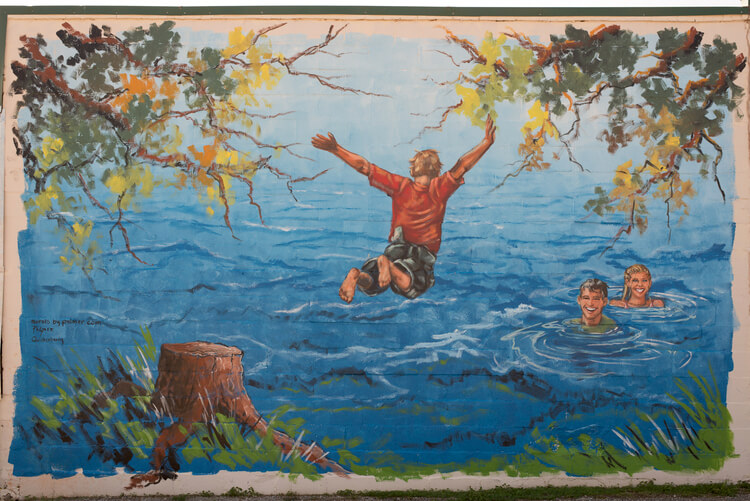
NonDoc was unable to obtain contact information for Baker.
Hutchings said she was vacationing in Key West, Florida, and was aggravated to be receiving calls from media about the mural flap. She referred to the mural as “ugly” twice more.
“I’m sorry that people are getting upset,” she said. “I don’t know what else to tell you.”
Smith said Hutchings and Baker should have shown more respect for the relatively new mural and for the artist.
“It doesn’t matter if people think it’s ugly. That’s not the point with art,” Smith said. “A guy like Bob Palmer didn’t deserve that.”
Smith said that while the building owner has the right to do what he and a new tenant want, he wishes due diligence had been done for a mural only two years old that was funded by a gift from Google and is featured on the Google Cultural Institute.
“At least have some respect. There’s a signature on that painting. We can find that guy. You’re a member of the Western Avenue Association. Let’s at least take a photograph of it,” Smith said. “I intend to see it through because I owe a guy like Bob Palmer who literally, brick by brick, paved the path for us to have an octopus downtown, for Dylan Bradway’s stuff, for Wayne (Coyne’s Womb).
“People in this town seemingly don’t care enough to have a little respect and pick up the phone.”
Follow NonDoc:
‘That sounds like shitty PR’
When Palmer saw that his mural had been painted over Friday, he said it hurt.
“It’s sort of like being kicked in the stomach,” he said. “You do things to the best of your ability in the hope that the public appreciates it, and they stay awhile. I don’t expect them to be there forever, but I actually thought that one should have been up there longer than that.”
Palmer, who retired from UCO in 2014, said he would never cover up someone else’s work.
“It doesn’t give you any opportunity to go and take a picture of it,” Palmer said of the sudden disappearance of his piece. “It’s kind of like your children. You’ve done your best to produce them and create them, and then for someone not to be sensitive to them, that’s just being a little reckless to me — someone being that insensitive to someone else’s work.”
After Smith spoke with Hutchings on the phone, he echoed Palmer’s sentiments.
“She said, ‘I don’t know what everyone’s upset about. It’s not like it’s the Mona Lisa,’” Smith said. “Well, what makes the Mona Lisa the Mona Lisa? You can’t insert an opinion into something that’s subjective.”
Smith, who owns Weldon Jack at Northwest 36th Street and Western Avenue, said such a bold move seemed odd for a business owner moving into a new district.
“There was just no courtesy, and courtesy goes a long way here,” Smith said. “She kept saying, ‘Why am I dealing with this on my vacation?’ Well, the fact is she wouldn’t be if she had just paid a little courtesy.”
OKC artist and writer Jack Fowler offered a similar take.
“That sounds like shitty PR,” Fowler said. “Oklahoma City is still a small town. It’s just a bad way to behave in a small town.”
Fowler’s was the brush behind the new Bricktown Octopus, a controversial mural in its own right that some people love and some people don’t.
“I feel really bad for the guy,” Fowler said of artist Palmer. “It does boil down to a respect issue. No matter what (Hutchings) does want to put up there, it did show a lack of respect for a guy. I know how hard those are now. I know what he put into it. That was a community effort, part of a community project. It is disrespectful, if nothing else.”
Fowler emphasized that he does not believe additional regulations should be added for what a property owner can or cannot do with their building’s walls, and Palmer and Smith both noted that artists need to do a better job of formalizing agreements with landlords in writing.
But Fowler remained confounded by the new red wall that stands where the mural used to.
“It’s not a good way to endear yourself to the business community, I wouldn’t think,” he said. “If we feel that strongly about it that she’s done something wrong, we can tell her that by not shopping at her business.”
He said he doesn’t know whether he will personally take that sort of step, but he said that’s likely the only leverage that offended community members may have.
“How we respond will determine whether someone does this again,” Fowler said.










